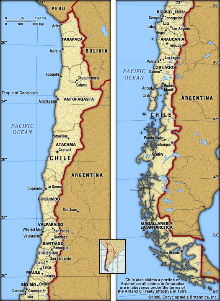After a lot of thinking we decided to go this time to Chile. We had been there a couple of years ago but had visited only
the south so this time we made the north. We went to the desert.
Contrary to the very wet south northern Chile is comprised in part by the driest desert on Earth, the Atacama Desert.
The Andes Mountains form a rain shadow for the easterly winds while the cold Humboldt Stream from Antarctica hinders the
formation of rain clouds. In some parts of this desert there has been no precipitation reported in 400 year's records.
Water is only found in the valleys where rivers flow that have their origin in melting snow from the Andes. In spite of
the aridity the climate is fresh because of the Humboldt Stream.
 Once in Santiago we were picked up at the airport with the booked rental car. Then we went on to the bathing resort
Pichidangui 220 kms north of Santiago. There we lodged in a "cabaña" (a hut) in order to take a rest from the long flight.
To our surprise the owner was a German from Frankfurt. The next day we went on to the north. Underway we picked up a man
and his daughter who were travelling to La Serena. They told us that the desert was blossoming.
Once in Santiago we were picked up at the airport with the booked rental car. Then we went on to the bathing resort
Pichidangui 220 kms north of Santiago. There we lodged in a "cabaña" (a hut) in order to take a rest from the long flight.
To our surprise the owner was a German from Frankfurt. The next day we went on to the north. Underway we picked up a man
and his daughter who were travelling to La Serena. They told us that the desert was blossoming.
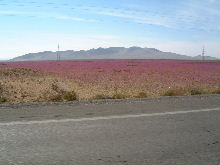 It was true. After Vallenar we discovered a violet carpet. It consisted of thousands and thousands of small flowers, all
in the same color. Later we also saw yellow carpets. Approximately every 5 years the phenomenon known as "El Niño" (an
abnormal temperature rise in the ocean surface) causes rain on the desert. And then this natural show comes into being.
It was true. After Vallenar we discovered a violet carpet. It consisted of thousands and thousands of small flowers, all
in the same color. Later we also saw yellow carpets. Approximately every 5 years the phenomenon known as "El Niño" (an
abnormal temperature rise in the ocean surface) causes rain on the desert. And then this natural show comes into being.
Shortly after Caldera we visited a natural reserve with strange orbicular granite. Incrusted in the stones are small spheres
so the rocks looked like they had smallpox. There we spoke with fishermen who told us about the next elections. They dive to
fish. I just noticed how lucky I am that I don't have to do this as a job, swimming in the cold sea.
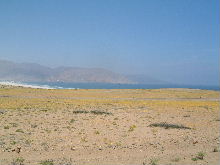 Then we reached the small city of Chañaral. Later we were told that beacuse of the dense fog it is dangerous to drive here
at night. The cold Humboldt Stream causes the formation of fog so that at the coast it is always foggy. Only after
midday the sun came through. At 1000 m a fog forms that covers the mountain summits and is called "cachamanca".
Then we reached the small city of Chañaral. Later we were told that beacuse of the dense fog it is dangerous to drive here
at night. The cold Humboldt Stream causes the formation of fog so that at the coast it is always foggy. Only after
midday the sun came through. At 1000 m a fog forms that covers the mountain summits and is called "cachamanca".
Near Chañaral we visited the beautiful National Park Pan de Azúcar. We drove on a gravel road through the park. First
there was some vegetation as for example very nice cacti. More into the land it became more and more arid until at last there
were no more plants. The bare mountains had incredible colors which varied with the mineral content from yellow through
green to red.
After the national park it was 400 kms wasteland up to the city of Antofagasta. You cannot imagine a drier desert. Just
about nothing grows here. We wanted to see Antofagasta on the return so next day we continued to Iquique. Iquique grew
because of the nitre which was mined nearby. The surrounding desert is full of salts, probably because it almost never
rains. Before the development of the synthesis of Ammonia by the Germans Haber and Bosch salpeter was used as fertilizer and
for the production of explosives. Many a fortune and oppulent villas came into being. Water had (and has) to be pumped
through pipes hundreds of kilometers long from the mountains to the city. Today Iquique lives from the export of fish flour
which is used e.g. for feeding salmon.
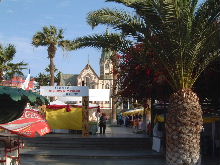 The desert remained desolate all the way up to Arica. Directly at the coast the mountains climb over 1000 m. To cross the
valleys the road takes slopes of 15 or 20 kms which are very steep. Many trucks have accidents and there are lots of small
shrines at the accident places.
The desert remained desolate all the way up to Arica. Directly at the coast the mountains climb over 1000 m. To cross the
valleys the road takes slopes of 15 or 20 kms which are very steep. Many trucks have accidents and there are lots of small
shrines at the accident places.
In Arica there is a chruch which was designed by Auguste Eiffel, the designer of the Eiffel Tower in Paris. The church
is built in iron. Eiffel worked in South America between 1872 and 1874. Arica ws then part of Peru/Bolivia. After the
Salpeter War (1879-1884) the region went over to Chile.
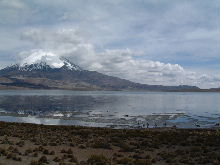 After Arica we went into the country away from the coast and up to the Andes to the town of Putre and Lauca National Park
near the border to Bolivia. Lauca is 4500 m high. Parinacota Volcano, which is mirrored on Chungará Lake, is 6348 m high.
In Lauca we were
able to watch vicuñas, a camel species akin to lamas. Vicuñas were endangered but thanks to the efforts of the Chilean
government they have made a comeback. At Lauca there are also many vizcachas, which are related to chinchillas. With
increasing height the probability of rain also increases. Coming from Arica first there are no plants at all. Between
2500 and 3000 m one encounters candelaber cacti which live from the fog that forms from sea moisture. In Lauca there is
enough water for different plants and even for mammals to live. At this height every effort was exhausting. Even a small
hill seemed unsurmountable and there was a very fresh breeze. At this time of the year there was no frost during the day
though.
After Arica we went into the country away from the coast and up to the Andes to the town of Putre and Lauca National Park
near the border to Bolivia. Lauca is 4500 m high. Parinacota Volcano, which is mirrored on Chungará Lake, is 6348 m high.
In Lauca we were
able to watch vicuñas, a camel species akin to lamas. Vicuñas were endangered but thanks to the efforts of the Chilean
government they have made a comeback. At Lauca there are also many vizcachas, which are related to chinchillas. With
increasing height the probability of rain also increases. Coming from Arica first there are no plants at all. Between
2500 and 3000 m one encounters candelaber cacti which live from the fog that forms from sea moisture. In Lauca there is
enough water for different plants and even for mammals to live. At this height every effort was exhausting. Even a small
hill seemed unsurmountable and there was a very fresh breeze. At this time of the year there was no frost during the day
though.
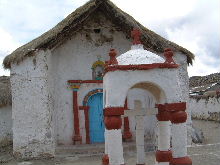 Between Lauca and Putre lies a charming little town with a lovely church. In Parinacota live Aymara indians. Chile's
population is mainly caucasian. Most are descendants of the Spaniards. There are also many Germans. It is rare to meet
indians. As this region belonged formerly to Bolivia though, the percentage of natives is much higher.
Between Lauca and Putre lies a charming little town with a lovely church. In Parinacota live Aymara indians. Chile's
population is mainly caucasian. Most are descendants of the Spaniards. There are also many Germans. It is rare to meet
indians. As this region belonged formerly to Bolivia though, the percentage of natives is much higher.
Returning to Arica we stopped in a further picturesque Aymara village, Socoroma. There we also visited the church. The
cemetery was full of colorful paper flowers. It was a Sunday morning. Sadly most of the men were drunk even as it was not
yet midday.
During the 100 km long drive back to Arica it almost wasn't necessary to push on the gas pedal. Because of the enormous
difference in height the car rolled as in a roller coaster.
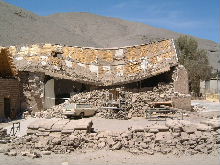 Back in Arica we visited the archaeological museum in Azapa. There, 7000 year old mummies are displayed, the oldest in the
world. They belong to the Chincorro culture. Then we went on south. A small side trip from the Panamerican Highway lead
us to Tarapacá. After an earthquake in June 2005 most of town was rubble. We dind't know that. We were told there hadn't
been any casualties.
Back in Arica we visited the archaeological museum in Azapa. There, 7000 year old mummies are displayed, the oldest in the
world. They belong to the Chincorro culture. Then we went on south. A small side trip from the Panamerican Highway lead
us to Tarapacá. After an earthquake in June 2005 most of town was rubble. We dind't know that. We were told there hadn't
been any casualties.
On the further way south we stopped at Humberstone near Iquique. Humberstone is one of the many former facilities for mining
salpeter (natrium nitrate). Mine and city at the same time, we visited the rusted facilities and also the settlement which
includes theater, school, market, hotel and the living quarters of the workers. Most interesting was the swimming pool,
an enormous tub in the middle of the desert made of iron recovered from a shipwreck. Then we went on to Pica and Matilla
where there are thermal baths. We were shocked as we saw that the church in Matilla had collapsed in September two months
after the quake. Fortunately there were no casualties.
In Cerros Pintados we were able to admire the geoglyphs. Geoglyphs are everwhere in the north. They are drawings on the
mountains made by scraping the earth or aligning rocks. As it doesn't rain much they are not eroded and survive to this day.
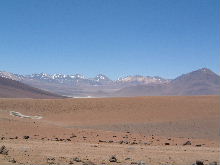 During the following days we reached San Pedro de Atacama, a manicured place with many tourists. Here we stayed two days.
On the first day we drove up to the border with Argentina to Paso Jama. First we climbed the plateau with a stunning
view of Licancabur volcano. Along the border to Bolivia there was an incredible view of Laguna Verde and the multicolored
mountains behind. Then we reached Los Flamencos National Reserve where we spotted flamingos but also ducks, geese and
vicuñas. The breeze was fresh and the air clear. Then we reached another lagoon of the reserve in very nice fair
and dark blue shades beside the white color of salt deposits.
During the following days we reached San Pedro de Atacama, a manicured place with many tourists. Here we stayed two days.
On the first day we drove up to the border with Argentina to Paso Jama. First we climbed the plateau with a stunning
view of Licancabur volcano. Along the border to Bolivia there was an incredible view of Laguna Verde and the multicolored
mountains behind. Then we reached Los Flamencos National Reserve where we spotted flamingos but also ducks, geese and
vicuñas. The breeze was fresh and the air clear. Then we reached another lagoon of the reserve in very nice fair
and dark blue shades beside the white color of salt deposits.
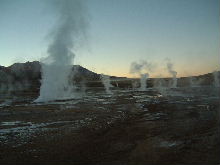 The next day we started already at 4:00 am to El Tatío geysers. These have to be reached before dawn as the steam columns
disperse with the sun and wind during daytime. It was very cold at this time and an altitude of 4500 m, about -8 °C.
My toes were numb with cold but the view was spectacular. Hot water bubbled from the ground at a temperature of 85 °C,
the boiling point of water due to the reduced pressure at this height. During the return trip to San Pedro we stopped at
the little town of Machuca with its picturesque little church. We were lucky as it was open and we could inspect its
interior.
The next day we started already at 4:00 am to El Tatío geysers. These have to be reached before dawn as the steam columns
disperse with the sun and wind during daytime. It was very cold at this time and an altitude of 4500 m, about -8 °C.
My toes were numb with cold but the view was spectacular. Hot water bubbled from the ground at a temperature of 85 °C,
the boiling point of water due to the reduced pressure at this height. During the return trip to San Pedro we stopped at
the little town of Machuca with its picturesque little church. We were lucky as it was open and we could inspect its
interior.
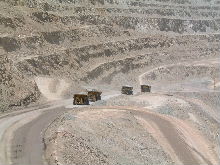 After San Pedro we went back through Calama and Chuquicamata were we visited the biggest open pit copper mine in the world.
The mine is 875 m deep. Chile's reserves and production amount to 18 % of the world's copper. Copper was nationalized under
Salvador Allende from American companies. Today the government receives the earnings which then benefit all Chilean
citizens.
After San Pedro we went back through Calama and Chuquicamata were we visited the biggest open pit copper mine in the world.
The mine is 875 m deep. Chile's reserves and production amount to 18 % of the world's copper. Copper was nationalized under
Salvador Allende from American companies. Today the government receives the earnings which then benefit all Chilean
citizens.
After arriving in Coquimbo near La Serena we made a day tour to the Elqui River Valley. The Elqui is a small river which
winds through the dry mountains. In the valley wine is cultivated. The famous pisco sour comes from here (in the valley
there is a town named Pisco), a brandy which is served with lime juice. The contrast between the dry mountains and the
green valley couldn't be bigger.
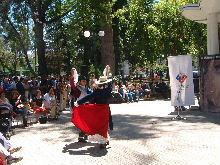 Towards the end of the trip we enjoyed a performing of the cueca, the national dance. We were sitting in the plaza in San
Felipe, listening to a manifestation against violence on women. At the end a group of students performed the cueca.
Towards the end of the trip we enjoyed a performing of the cueca, the national dance. We were sitting in the plaza in San
Felipe, listening to a manifestation against violence on women. At the end a group of students performed the cueca.
Chile is a land of landscape contrasts. From the world's driest desert in the north to the rain forest in the south people
are friendly and welcoming. There is a sense of optimism. And there are lots of untouched nature. We wish this land it may
reach the high self-imposed goals and that it may live in social peace.
Hermann Luyken
Ludwigshafen, 10.12.2005
Contact: Hermann Luyken
Ludwigshafen
Home
